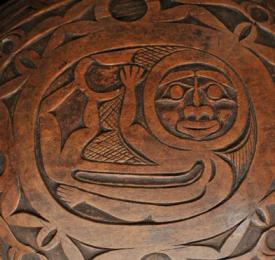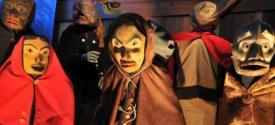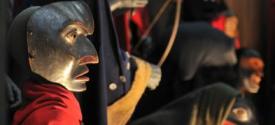Nisga'a Artifacts



Hli Goothl Wilp-Adokshl Nisga’a, the Nisga’a Museum, is a celebration of transformation. Consisting of objects that left the Nass Valley at a time of radical change, the Nisga’a Museum proudly proclaims the distinctive Nisga’a art and cultural symbols that were once so misunderstood by the outside world. Hli Goothl Wilp-Adokshl Nisga’a means “The Heart of Nisga’a House Crests.” The design of building takes its inspiration from traditional Nisga’a forms, such as longhouses, feast dishes, and canoes.
Nisga’a society is organized into four pdeek (tribes): Laxsgiik (Eagle), Gisk’asst (Killer Whale), Ganada (Raven), and Laxgibuu (Wolf). The museum’s name commemorates the importance of pdeek and adoks (tribal crests) in Nisga’a culture. In the late 19th century, Methodist and Anglican missions were established in villages along the Nass River. By that time, the government of Canada was using its authority to assume control over aboriginal people by entering into a partnership with the Christian churches. In the Nass Valley, as elsewhere across British Columbia, the missionaries and federal Indian agents came to regard the resistance of the tribes and house chiefs as the most serious impediment in their efforts to convert and “civilize” aboriginal people. The Nisga’a had already been dealing with white explorers and fur traders for several decades. Pragmatic traders themselves, the Nisga’a had, from first contact, shown a willingness to borrow and share with foreign cultures. But as churchmen set up their missions along the banks of Lisims (the Nass River), they introduced a harsh, new order with little room for compromise: Accept the terms of a new religion or face eternal damnation. Tragically, many missionaries also mistook Nisga’a tribal symbols for shamanism or idolatry.
History shows that the Nisga’a and other First Nations who converted to Christianity were often coerced—in fear of eternal damnation—into giving up their rattles, headdresses, ritual pipes, canoes, baskets, masks, and totem poles. Many missionaries sold the artifacts to traders who in turn sold them to museums around the world. During the late 1800s and early 1900s, Nisga’a people also willingly sold their possessions in the west coast artifact market in order to participate in the new cash economy. Many possessions were also proudly given as gifts to visitors.
Nisga’a Treaty & Repatriation
The Nisga’a Final Agreement, British Columbia’s first modern treaty, came into effect on May 11, 2000. The return of these artifacts is a result of the landmark Nisga’a Treaty. It fulfills the obligation of Chapter 17, which states: “The Parties (to this treaty) recognize the traditional role of Nisga’a artifacts in the continuation of Nisga’a culture, values, and traditions.” It recognizes that we have a “traditional and sacred connection” with these artifacts. Nisga’a negotiators worked to secure a treaty that brings these treasures home. For more information, visit the Nisga’a Museum: http://nisgaamuseum.ca/
